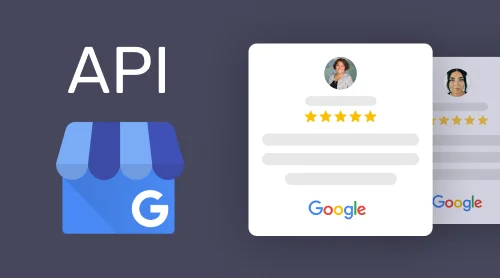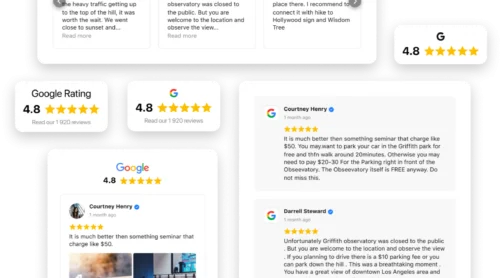Why does it matter to have a star rating?
Star snippet is a special Google search result which includes additional information stored as structured data. It looks like stars just under the page title and tells users that this website is trustworthy.

Review rich snippets are eye-catching and help any site stand out from the crowd. They provide people with additional information about product and the whole website. A sense of confidence is invoked in shoppers when they see how other users rate items and services, they are more likely to make a purchase.
Furthermore, google review rating enhances traffic to the website, boosts people’s engagement. Depending on your initial ranking, a Google review rich snippet can increase CTR by up to 30%. You may see results of Elfsight inner research about review snippets below:
| Device | CTR without star snippets (weekly) | CTR with star snippets (weekly) | Growth |
| Desktop | 4,04% | 4.49% | +10% |
| Mobile | 3,4% | 4,9% | +31% |
The effect is great, and you’ll be impressed by how easily it can be achieved after implementing reviews snippet in Google. Let’s start with choosing your own variant of star rating.
Types of Google Review Rich Snippets
There are different kinds of Google rich snippets star ratings depending on what type of content is being reviewed. Below, you’ll see who needs them and how they can be added to the snippet.
Snippet 1: Local Business
To stand out from the competitors, business should give stunning ratings in Google results. For local businesses, Google search results rich snippets help show such key information as operating hours, location, and contact details, alongside the Google star rating.
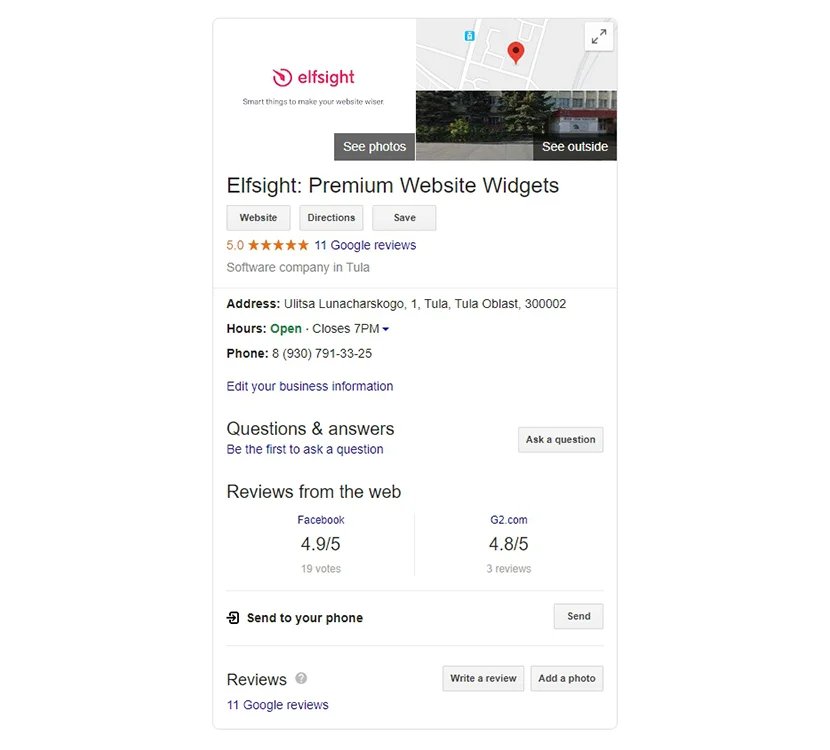
With such detailed information it is incredibly easy to make your business remarkable. You may use local business snippet in the following cases:
- On a page dedicated to a single local business, such as a restaurant, salon, or service provider.
- On a directory page that lists several local businesses, offering users the ability to compare based on reviews and ratings.
- On a landing page showcasing customer testimonials for a particular service area or branch of your business.
Snippet 2: Product
Product pages can leverage Google rich snippets reviews by adding product-specific structured data. Besides star rating users can see pictures, price, and availability.

You may use rich product markup in the following cases:
- On a page that describes a single item.
- On a shopping comparison page, where a single product is presented along with information about different sellers of it.
- On a marketplace that aggregates a product from multiple sellers, helping users choose the best seller based on ratings.
This type of snippet is ideal for increasing the visibility of individual products and boosting conversion rates by building trust through customer feedback.
Read moreSnippet 3: Recipe
Recipes are also rated in Google search results. The content in snippet is well structured, users are provided with information about cooking and preparation time, and about nutrition.

Apply Google review schema to your recipe snippet, whether you have:
- a page featuring a single recipe, where users can rate the difficulty or taste,
- a collection page that offers multiple recipes for a specific dish or cuisine, each with its own review and rating,
- a blog post featuring user-generated recipes, allowing the audience to rate their favorites.
People will more likely visit the website when they see it on Google. Clear ratings and reviews can help recipe pages stand out, especially for users searching for new dishes to try based on others’ experiences.
Read moreOther types
To show star rating in any other situation, use aggregateRating property for google review schema markup. This is what the code looks like after you’ve added it.
<div itemprop="aggregateRating"
itemscope itemtype="schema/AggregateRating">
Rated <span itemprop="ratingValue">3.5</span>/5
based on <span itemprop="reviewCount">11</span> customer reviews
</div>There are many more cases, when people can rate the materials. Here are all the types of content that support rating markup: games, music playlists, movies, software apps, courses, brand, creative works, events, offers, organizations, places, products, services, articles – with the help of aggregateRating property.

Sometimes official schema.org documentation doesn’t coincide with Google’s guide for placing reviews. There is a likelihood that stars will not appear in snippets or Google will hit manual actions towards the website because of review markup spam.
Read moreHow Does the Google Star Rating Work?
The Google star rating system is a visual representation of user feedback and reviews, collected from a variety of sources, including third-party review platforms, user-generated reviews, and structured data on websites that use review rich snippets.
This data is aggregated to calculate the average rating and displayed as a series of stars that range from 1 to 5. Each star reflects the average rating of a product, service, business, or any other entity reviewed by users, providing an instant overview of customer satisfaction.
The stars, typically displayed directly below the website link in Google search results, are designed to give users a quick insight into how others rate that product or service.
For example, if a business has received 50 reviews with an average score of 4.5 out of 5, Google will display 4.5 stars in search results. This visual cue helps users quickly assess the quality of the business or product, encouraging them to click through.
Benefits of the Google Star Rating
1. Increased Click-Through Rates (CTR)
Websites displaying rich snippets with star ratings tend to attract more attention from users, standing out from competitors who lack this feature. A high Google review star rating makes your listing more visually appealing, drawing users in and encouraging them to click through to your website. As we mentioned before, businesses that display Google review rich snippets can see up to 30% CTR increase and drive more organic traffic to their site.
2. Enhanced Credibility and Trust
It’s natural for users to trust peer reviews when making decisions about products or services. A high star rating in search results communicates reliability, quality, and trustworthiness at a glance. When potential customers see that others have had positive experiences with your business, they are more likely to follow through and engage. Whether it’s a local business, product, or service, a solid Google star rating builds instant credibility.
3. Higher Conversion Rates
Improved visibility and trust also translate to higher conversion rates. Once users land on your website after seeing a strong star rating, they are more inclined to make a purchase or take action. Reviews and ratings give users the confidence to move from browsing to buying, knowing that others have already had satisfactory experiences.
4. Competitive Edge
In highly competitive industries, having a star rating can be the difference between capturing a lead and losing one. Search results are crowded with businesses vying for attention, but rich snippet stars help your listing stand out from the crowd. Even if you rank below competitors, the presence of Google review stars can draw users to your site, leveling the playing field and helping you outshine competitors who don’t display them.
5. Improved User Experience
Google star ratings also contribute to a better overall user experience. They offer a quick way for users to understand the quality of a business or product without having to explore deeply individual reviews.
Does the Google Star Rating Influence SEO?
While Google star ratings themselves are not a direct ranking factor, they have an undeniable influence on key SEO metrics. The increased CTR, user engagement, and dwell time generated by star ratings all contribute to positive signals for Google’s ranking algorithm. Websites with rich snippet reviews often experience a boost in search visibility because of improved user interaction. And this indirectly enhances their SEO performance.
How to get a Google rating in search results?
There are few ways to make a review snippet for a website. In the majority of cases it is a necessary to code, but by means of certain tools you’ll be able to show reviews without having to program.
Way 1. Make a custom widget
If you utilize pre-made solutions, such as Elfsight Reviews widget, you shouldn’t waste hours on learning Google review schema and programming. The plugin collects and aggregates testimonials automatically, its installation requires no programming skills.
So if you feel like displaying more detailed information of your page with the installed widget on Google search, you just need to enable Schema.org option in your Elfsight Reviews widget’s settings on the Settings tab.
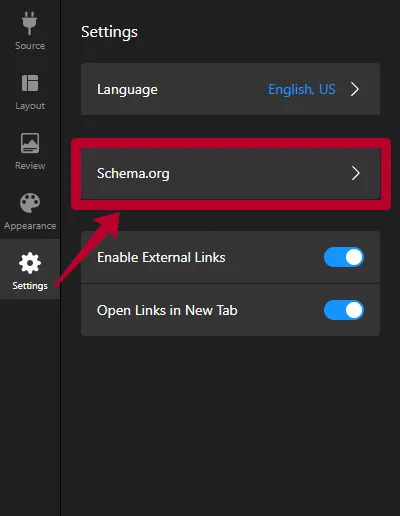
Elfsight All in One Reviews widget guarantees a practical star rating to appear in search results.
Way 2. Add schema markup to HTML code
If you have coding skills, manually adding Google rich snippets star rating code to your website is another option. Open HTML of one web page or template and directorily insert schema markup into it. Find the needed strings and add several fragments into them. You see the way how code appears in the absence of schema.org markup:
<a href="example-url/dell-30.html">
Save A Lot Monitors - $1250</a>
<a href="example-url/dell-30.html">
Jon Doe's Gadgets - $1350</a>It looks like this right after you have inserted google review schema:
<div itemprop="aggregateRating"
itemscope itemtype="schema/AggregateRating">
<span itemprop="ratingValue">87</span>
out of <span itemprop="bestRating">100</span>
based on <span itemprop="ratingCount">24</span> user ratings
</div>This method requires the capacity to code and understand the program.
Way 3. Add a fragment of JSON code
JSON is a lightweight format for transferring and classifying information. It’s more convenient to implement than the schema markup. You should place it just after the title of the page into HTML. Below, you can see an instance of JSON code with reviews.
<script type="application/ld+json">
{
"@context": "schema",
"@type": "Review",
"itemReviewed": {
"@type": "Restaurant",
"image": "example-url/seafood-restaurant.jpg",
"name": "Legal Seafood"
},
"reviewRating": {
"@type": "Rating",
"ratingValue": "4"
},
"name": "A good seafood place.",
"author": {
"@type": "Person",
"name": "Bob Smith"
},
"reviewBody": "The seafood is great.",
"publisher": {
"@type": "Organization",
"name": "Washington Times"
}
}
</script>This process demands the ability to program because you will have to comprehend the code and rewrite some lines in accordance with your needs.
Way 4. Apply Google Tag Manager without rewriting the code
This tool permits programmers to make the needed fragment of code without knowing how to program. This tool is a JSON generator which facilitates to make a fragment of JSON markup without the assistance of professional programmers.
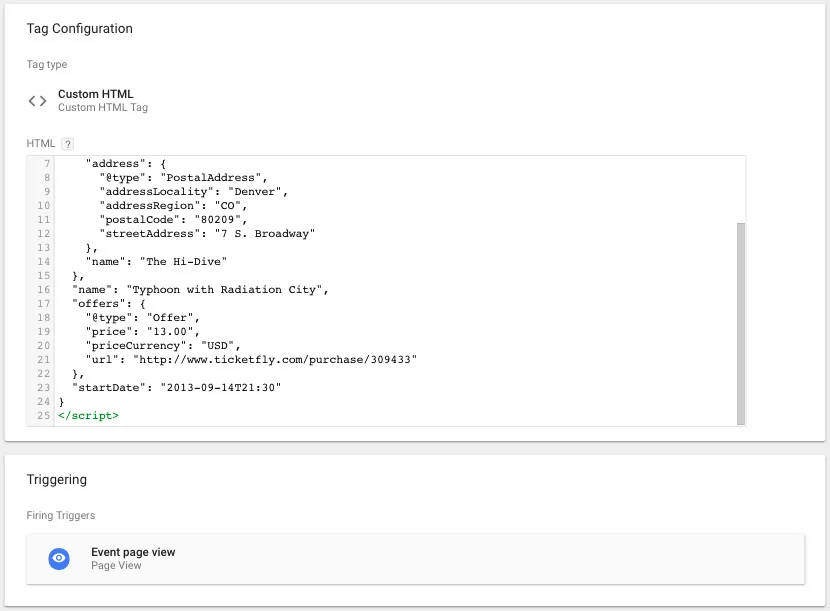
The interface of GTM is pretty simple, but you are required to know the code of a page to embed it. Although it’s not very hard to understand, this approach still demands developer’s capacity.
Way 5. Use Google Structured Data Markup Helper
It is a tool which helps programmers and non-professionals easily implement structured data on their websites. It’s quite easy to use. All you need is to embed the code and use the editor to get ready JSON or HTML markup for a particular page.
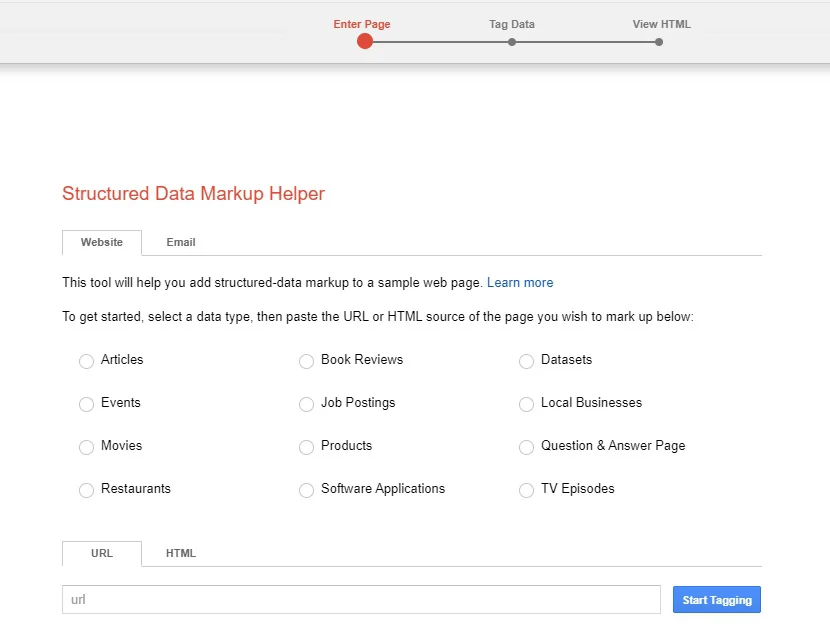
As in the previous example, you are to know the structure of a webpage to add it. It’s not very complicated, but still this method demands programming skills.
How to examine if the review snippets are executing appropriately
Before posting the website with added schema.org markup, verify everything. There are two main ways to do it.
Rich Results test
Rich Results test is a rapid and simple tool to facilitate you check performance of the schema markup. See if your website can produce rich results. The test will show which rich result types can be discovered on the web page, along with warnings or recommendations for your structured information.
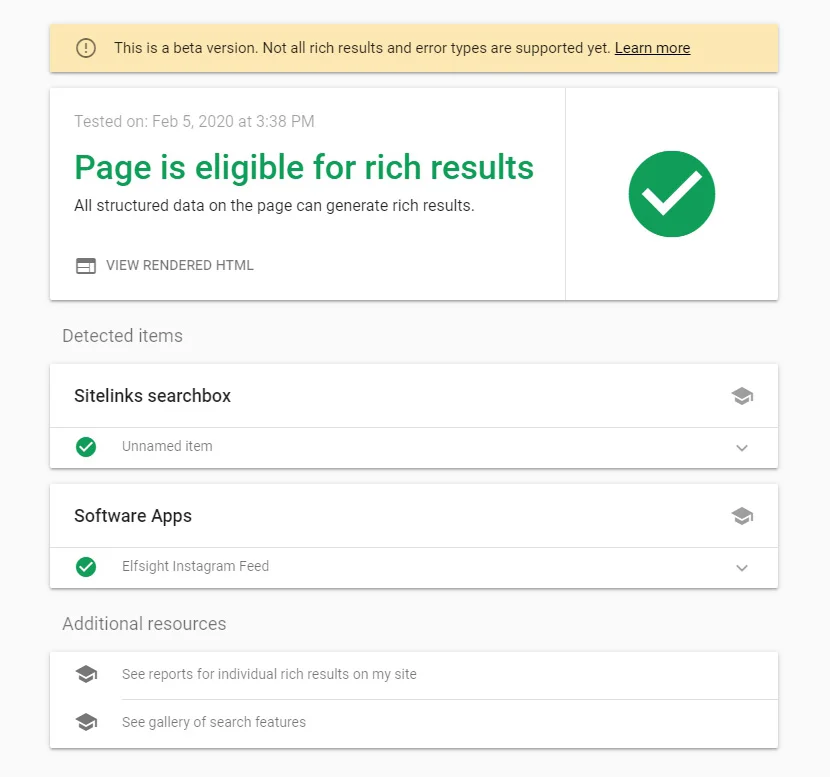
It’s a good idea to place ratings not only on search results page, but also embed Google reviews on your site.
Google Search Console
This instrument is going to support you to discover all the warnings occurring in your schema markup. Only open the report in the navbar of the Search Console. Bear in mind that you’ll see a report merely if you have code for review snippet on the website.
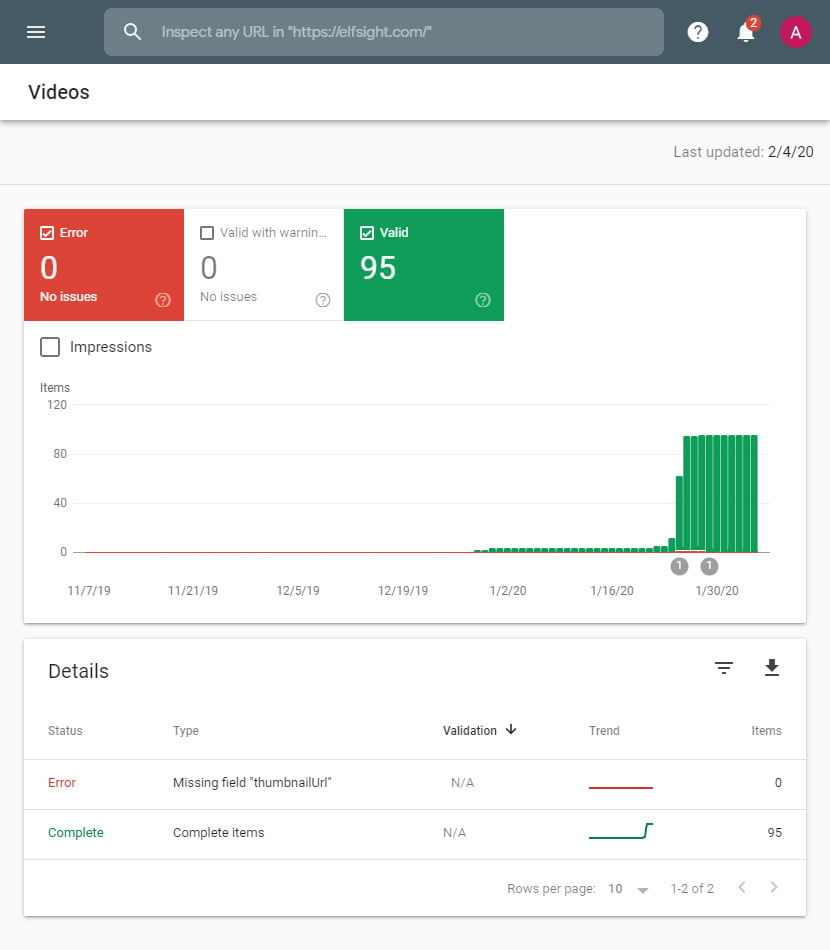
Tip: Schema is recognized by Google, Bing, Yahoo!, and Yandex. It’s not apparent if other search engines are using this markup.
My review snippets don’t show up in Google. What went wrong?
1. Google Search Engine hasn’t indexed your website yet.
Request indexing by providing your recent URL to Google. Bots will look through your page after that. If nothing has happened, check out the site for other possible errors.
2. The structured data is configured incorrectly
Before posting the website with star ratings, try to carry out a Rich Result test; it will clearly stress errors and warnings.
3. You are following the structured data guidelines incorrectly
Look through the full list of structured data guidelines and make sure you have done everything according to it.
4. Google isn’t showing star rating for your kind of content
5. You used several markup languages
Utilize only one of the methods of realizing the schema markup: RDFa, Microdata or JSON-LD – and don’t mix them because it can lead to invalid displaying of review snippets.
6. And a couple more
There are several more reasons why rich snippets aren’t performing appropriately.
- Google search engine doesn’t see your site as worth trust – you should prove its authenticity.
- You’re utilizing organizational markup – itemscope. Remember that it rarely appears.
- Your website consists of too few pages, or not all the pages have structured data. Check it out.
- It isn’t guaranteed that proper implementation of the schema markup will help review snippets to appear.
In some cases, all you have to do is wait – Google doesn’t detect marked up content right away.
How to Improve Your Google Star Rating
To boost your Google star rating and build trust, focus on a few simple yet effective strategies. Start by delivering excellent service – happy customers are more likely to leave positive reviews. Address any issues quickly, exceed expectations, and make sure that every customer interaction leaves a good impression.
Don’t hesitate to ask for reviews from satisfied clients. You can easily request feedback through follow-up emails or notifications and include a direct link to your review page. If you’re not sure how to share the link, check out this guide on how to send Google review links.
Handling negative reviews professionally is equally important. Respond promptly, offer solutions, and show that you’re proactive. This can help restore trust. For tips on finding reviews more easily, take a look at this guide on efficient review searches.
Encouraging detailed, honest feedback adds credibility. Longer, more insightful reviews are more likely to be featured in search results. Make sure your service remains consistent, so positive reviews can steadily balance out any occasional negative ones.
Lastly, keep your business listings up to date and use Google Review widget to monitor and manage feedback. Responding to reviews and analyzing trends will help you continuously improve your service.
By following these strategies, you’ll enhance your star rating, build credibility, and improve your online presence.
Google’s manual actions for review markup spam
Attempting to manipulate Google instructions can lead to manual actions during the assessors’ inspection.
For example:
- If you mark up the ratings which are hidden to users
- If you make up the irrelevant and untrustworthy content
To remove a hit with manual action from your website, look through Google’s technical guidelines on implementing the markup. Check code and make sure it is configured accurately for the review markup content. As soon as you’ve set all the lines that are violating Google’s guidance, forward a request to check the website once more. It will be approved in about a week or less.
Conclusion
The use of review snippets has become a standard of SEO-optimisation. Star ratings make your website outstanding and let it distinguish itself from the majority not using it. If you don’t use this instrument, you’re losing traffic now.
Tell us, do you implement review snippets on a website? What other rich snippets do you want to use? What interesting and peculiar examples of them have you ever noticed in search results?
Almost every website needs star rating to boost CTR and improve entire SEO. With ready-made solutions by Elfsight it’s super-easy to start using them. Try the widget below right now.
BONUS: widget for creating a star rating out of your reviews!
FAQ
How does Google calculate star ratings?
Google calculates the star rating based on the average of user reviews submitted on the platform.
Is a 4.5 Google rating good?
Yes, a 4.5-star rating is considered excellent, indicating strong user satisfaction.
How many 5-star reviews do I need to negate a 1-star review?
It depends on the number of total reviews. Generally, you need several 5-star reviews to balance out a 1-star review.
What should I do when I receive a 1-star review on Google?
Respond professionally and seek to resolve the issue. Your response can help mitigate the negative impact of a poor review.
How long does it take for Google star ratings to appear in search results?
It varies, but typically Google star ratings can take anywhere from a few days to several weeks to show up in search results.
Where can I get free schema code to display star ratings in Google search results?
While you can find free schema code examples online, manually implementing them can be complex and requires technical know-how. For an easier solution, Elfsight’s Google Reviews Widget offers a simple, code-free way to display your star ratings on your website.




